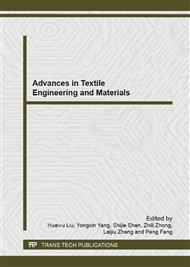p.3
p.15
p.19
p.23
p.29
p.33
p.37
p.43
Bias Reduction in Kernel Estimation of the Density Function of Cotton Fiber Length
Abstract:
Abstract. The non-parameter kernel estimation has become a dramatic method on fitting the distribution density function of cotton fiber length in theoretical research on fiber length. It can get a differentiable and integrable density function of cotton length distribution, and make the probability approach more effective on analysis and prediction of yarn performance. But, due to the requirements of the fitting smoothness, there is a bias between calculational index and measured value, especially to the short fiber content. This research uses the power function to fit the distribution of short fibers, then according to the principle of mixed distribution, revises the density function gotten by kernel estimation method, and gives a precise estimation of density function. The revised algorithm is more exact to fit the density function of fiber length. This approach is a new way to study the fiber length distribution and its effect on yarn properties both theoretically and practically.
Info:
Periodical:
Pages:
23-28
Citation:
Online since:
December 2012
Authors:
Price:
Сopyright:
© 2013 Trans Tech Publications Ltd. All Rights Reserved
Share:
Citation:


